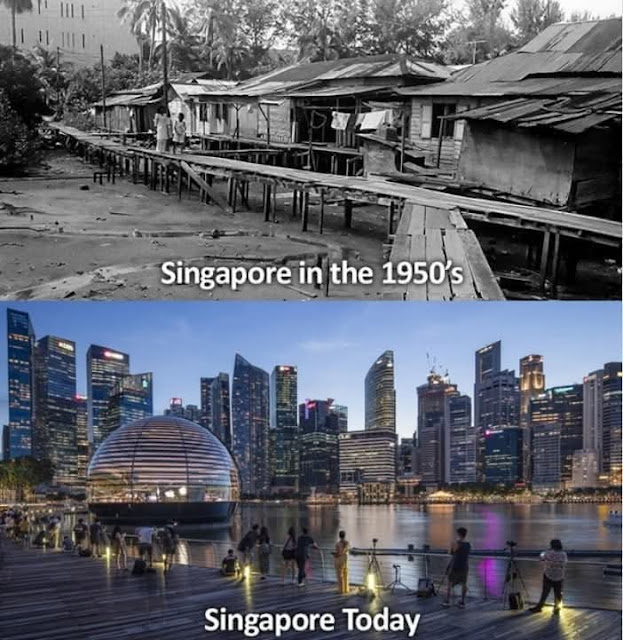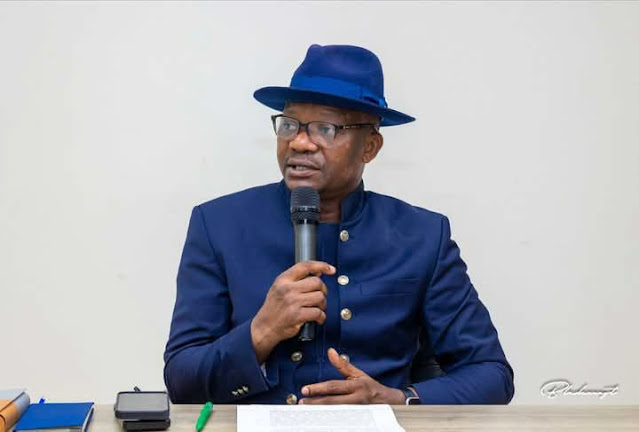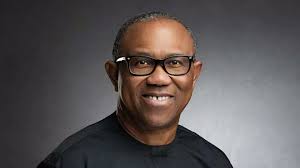On September 6, 2025, at a strategic leadership meeting held at Transcorp Hilton in Abuja, Joseph Omode, a prominent thought leader, addressed workers of Alexa News Nigeria, drawing inspiration from Singapore’s remarkable transformation as chronicled in Lee Kuan Yew’s memoir, From Third World to First: The Singapore Story, 1965–2000. Omode captivated the audience with a compelling narrative of how Singapore, a resource-scarce island nation, rose from a Third World state to a global economic powerhouse through visionary leadership, discipline, and resilience. He urged Nigeria to emulate Singapore’s principles of pragmatic governance, anti-corruption measures, human capital development, and economic diversification to unlock its vast potential.
Omode highlighted Singapore’s journey, noting its expulsion from Malaysia in 1965 left it with no natural resources, high unemployment, and ethnic tensions. Under Lee Kuan Yew’s leadership, Singapore prioritized export-led industrialization, attracting foreign investment through low taxes and efficient infrastructure. The Corrupt Practices Investigation Bureau ensured transparency, while investments in education and public housing transformed the nation. By 2000, Singapore’s GDP per capita exceeded $20,000, a stark contrast to Nigeria’s ongoing struggles with corruption, oil dependency, and infrastructure deficits.
He emphasized that Nigeria, with its 200 million-plus population and abundant resources, faces unique challenges but can adapt Singapore’s model. Omode called for consistent policies, robust anti-corruption agencies like Nigeria’s EFCC, and increased education funding to address the 10 million out-of-school children crisis. He advocated for economic diversification through special economic zones and infrastructure development, citing Singapore’s industrial estates as a blueprint. Social cohesion, vital for Nigeria’s diverse society, could be fostered through a reformed National Youth Service Corps, mirroring Singapore’s integration policies.
Omode acknowledged Nigeria’s democratic framework and cultural diversity require a nuanced approach, balancing discipline with inclusivity. “Singapore’s story is a challenge to Nigeria’s leaders to rise above adversity and harness our human potential,” he said. He urged Alexa News Nigeria to champion these ideas, fostering public discourse on transformative governance. Omode’s address inspired hope, underscoring that with visionary leadership and collective commitment, Nigeria can chart a path to sustainable development and global relevance.
On August 9, 1965, Singapore faced a moment of existential crisis unlike any in modern geopolitical history: it was expelled from the Malaysian federation, thrust into independence with little warning and even less certainty about its future. A tiny island of 581 square kilometers, with a population of just two million, no natural resources, and a fragile economy dependent on entrepôt trade, Singapore seemed destined for failure. Surrounded by larger neighbors, plagued by racial tensions, and grappling with high unemployment, the city-state’s prospects were bleak. Yet, under the visionary leadership of its founding father, Lee Kuan Yew, Singapore defied the odds, transforming from a Third World backwater into a global economic powerhouse within a few decades. This extraordinary journey, detailed in Lee Kuan Yew’s memoir From Third World to First: The Singapore Story, 1965–2000, stands as a testament to the power of pragmatic governance, disciplined leadership, and collective resilience. Joseph Omode will highlights Singapore’s improbable rise and implicitly critiques Nigeria’s struggles, urging its leaders to draw lessons from Lee’s strategies. Nigeria, with its vast population, natural resources, and cultural diversity, faces a starkly different context, yet the principles of Singapore’s success—anti-corruption measures, economic diversification, human capital development, and social cohesion—offer a compelling blueprint. This article explores Singapore’s transformation in exhaustive detail, analyzes Lee Kuan Yew’s leadership, compares Nigeria’s challenges to Singapore’s journey, and evaluates the feasibility of applying Singapore’s model to Nigeria and other developing nations, while addressing cultural, political, and structural barriers.
Historical Context: Singapore’s Birth in Crisis
To grasp the magnitude of Singapore’s transformation, we must first examine the circumstances of its birth. In 1965, Singapore was a small, resource-scarce island in Southeast Asia, a former British colony that had served as a trading hub since the 19th century. Its population was diverse—75% Chinese, 13% Malay, 7% Indian, and others—creating a delicate ethnic balance prone to tensions. The city-state lacked arable land, fresh water, or significant natural resources, and its economy relied heavily on entrepôt trade, with limited industrial capacity. High unemployment, inadequate housing, and the scars of World War II’s Japanese occupation compounded its challenges. When Singapore joined the Malaysian federation in 1963, it hoped to leverage the larger nation’s resources and markets, but deep-seated political and ethnic differences led to its expulsion just two years later.
The moment of separation was profoundly traumatic. In a televised address on August 9, 1965, Lee Kuan Yew, Singapore’s first Prime Minister and leader of the People’s Action Party (PAP), broke down in tears, describing the event as a “moment of anguish.” As he later wrote in his memoir, “Nobody in our generation who lived through that period in Singapore believed we could make it. The Federation of Malaysia, which we had joined in 1963, had ended in our ejection after two years”. Joseph Omode echoes this sentiment, noting that Singapore’s independence was “almost unheard of in modern geopolitical history,” as few nations have been forced into statehood against their will.
Singapore’s challenges were daunting: it had to build a nation from scratch, surrounded by potentially hostile neighbors like Malaysia and Indonesia, with no natural resources to fall back on. Racial riots in the 1960s, sparked by ethnic tensions, threatened social cohesion, while communist insurgencies in the region added to the geopolitical uncertainty. Yet, Lee and his team saw these challenges not as insurmountable barriers but as opportunities to forge a new path. “An island city-state in Southeast Asia could not be ordinary if it was to survive,” Lee wrote, encapsulating the mindset that drove Singapore’s transformation.
For Nigerians, this story resonates deeply. Nigeria gained independence in 1960, just five years earlier, under very different circumstances. Blessed with vast oil reserves, fertile land, and a population of over 40 million at the time, Nigeria was seen as a beacon of hope for post-colonial Africa. Yet, its trajectory diverged sharply from Singapore’s, marred by political instability, corruption, and ethnic conflicts, including the devastating Biafran War (1967–1970). Joseph Omode implicitly contrasts these paths, questioning why Nigeria, with its abundant resources, has not achieved similar success and suggesting that Singapore’s model holds valuable lessons.
Lee Kuan Yew’s Leadership: The Architect of a Miracle
At the heart of Singapore’s transformation was Lee Kuan Yew, a Cambridge-educated lawyer whose pragmatic vision and uncompromising determination shaped the nation’s destiny. Born in 1923 to a middle-class Chinese family, Lee was a product of Singapore’s colonial era, steeped in British legal traditions yet acutely aware of the challenges facing post-colonial societies. As the founding leader of the PAP, he navigated Singapore through its early years with a blend of intellectual rigor, strategic foresight, and relentless focus on results.
Lee’s memoir, From Third World to First, provides a detailed account of his leadership philosophy and the policies that drove Singapore’s success. Described by Henry Kissinger as an “extraordinary personality” capable of overturning “ordinary calculations,” Lee combined a global perspective with a granular focus on Singapore’s needs. His interactions with world leaders, including six U.S. presidents, gave him insights into global economics and politics, which he leveraged to position Singapore as a key player in international trade and diplomacy.
Key aspects of Lee’s leadership included:
Pragmatism Over Ideology: Unlike many post-colonial leaders who embraced socialism or nationalism, Lee prioritized practical solutions. He rejected protectionist policies that could stifle growth, instead opening Singapore to foreign investment and trade. “We decided to concentrate on getting factories started,” he wrote, noting that Singapore protected locally assembled goods like cars and electronics to encourage manufacturing, even with a small domestic market.
Anti-Corruption Zeal: Corruption was a pervasive issue in many newly independent states, but Lee made it a priority to eradicate it. The Corrupt Practices Investigation Bureau (CPIB), established in 1952, was empowered to investigate and prosecute corrupt officials, regardless of rank. Lee’s commitment to meritocracy ensured that public institutions operated with transparency, earning the trust of citizens and investors. “If we were a soft society then we would already have perished,” he wrote, underscoring the importance of discipline.
Economic Strategy: Lee’s government focused on export-led industrialization, recognizing that Singapore’s survival depended on global markets. Industrial estates, free trade zones, and low taxes attracted multinational corporations like Texas Instruments and Hewlett-Packard, transforming Singapore into a manufacturing hub. By the 1980s, the city-state had shifted to high-tech industries, such as electronics and pharmaceuticals, cementing its status as a global economic player.
Urban Planning and Infrastructure: Lee’s vision extended to the physical transformation of Singapore. The Housing and Development Board (HDB) provided affordable public housing for over 80% of the population, addressing the slum conditions prevalent in the 1960s. Infrastructure projects, such as Changi Airport and the Mass Rapid Transit (MRT) system, enhanced connectivity and livability. Lee’s attention to detail was legendary, from selecting shrubs for urban greening to restoring landmarks like the Raffles Hotel.
Education and Human Capital: Recognizing that Singapore’s greatest asset was its people, Lee invested heavily in education. Schools, technical institutes, and vocational training programs were established to create a skilled workforce. Bilingualism—English as a global language and a mother tongue (Mandarin, Malay, or Tamil)—ensured cultural preservation while facilitating international integration. This focus on human capital was critical to Singapore’s economic success.
Social Cohesion: Singapore’s multi-ethnic population posed a risk of communal strife, as seen in the racial riots of the 1960s. Lee’s government implemented policies to promote integration, such as mixed-race housing estates and mandatory national service, which fostered a shared national identity. While criticized for its authoritarian approach, this strategy ensured stability, allowing Singapore to focus on development.
Lee’s leadership was not without controversy. His “trenchant approach to political opponents” and restrictions on free speech, press freedom, and public assembly drew criticism from human rights advocates. In his memoir, Lee acknowledges these trade-offs, stating, “I always aimed to be correct, not politically correct.” He argued that a “soft society” would not have survived Singapore’s challenges, and his pride in fostering a “nanny state” reflects his belief in the necessity of discipline. This duality—visionary yet authoritarian—makes Lee a complex figure, admired for his achievements but scrutinized for his methods.
Singapore’s Economic Miracle: A Timeline of Transformation
Singapore’s journey from Third World to First World status is marked by distinct phases, each reflecting strategic shifts in policy and priorities. Below is a detailed timeline of key milestones, drawn from Lee’s memoir and historical analyses:
1965–1970: Laying the Foundation
Following independence, Singapore focused on survival. The government established industrial estates to attract foreign investment, offering tax incentives and efficient regulations. Multinational corporations set up factories, creating jobs and boosting exports. The HDB began constructing public housing, addressing the housing crisis. The CPIB cracked down on corruption, signaling Singapore’s commitment to integrity. By 1970, unemployment had dropped significantly, and the economy was growing at an annual rate of 8–10%.
1970s: Industrialization and Global Integration
Singapore expanded its manufacturing base, focusing on electronics, textiles, and petrochemicals. The Jurong Industrial Estate became a symbol of industrial progress, hosting companies like General Electric and Philips. The government invested in infrastructure, including the port and roads, to support trade. Education reforms ensured a skilled workforce, with technical institutes training workers for new industries. By the late 1970s, Singapore’s GDP per capita had risen from $2,200 in 1965 to over $5,000.
1980s: Transition to High-Tech Industries
Recognizing the limitations of labor-intensive industries, Singapore shifted to high-tech sectors like semiconductors and pharmaceuticals. The Monetary Authority of Singapore (MAS) was established, positioning the city-state as a financial hub. Changi Airport, opened in 1981, became a global aviation benchmark. The MRT system, launched in 1987, improved urban mobility. Singapore’s clean, efficient environment attracted banks and investment firms, solidifying its status as a global financial center.
1990s: A Global Metropolis
Singapore’s transformation into a modern metropolis was complete by the 1990s. The development of Marina Bay, with its iconic skyline, symbolized the city’s ambition. Investments in education and technology produced a highly skilled workforce, enabling Singapore to compete in knowledge-based industries. The port handled record cargo volumes, and Singapore Airlines became a global brand. By 2000, Singapore’s GDP per capita exceeded $20,000, rivaling developed nations.
2000s and Beyond: Innovation and Sustainability
Singapore continued to innovate, embracing technology and sustainability. Projects like Marina Bay Sands and Gardens by the Bay enhanced its global appeal. The government invested in renewable energy and smart city initiatives, maintaining Singapore’s edge in a competitive world. By 2025, Singapore’s GDP per capita was among the highest globally, at over $80,000, and it ranked consistently high on indices like the Human Development Index and Ease of Doing Business.
This transformation, described by Foreign Affairs as a “First World oasis in a Third World region,” was driven by Lee’s policies and Singapore’s ability to adapt to global trends. Joseph Omode underscores this achievement, noting that Singapore’s success was not a fluke but the result of deliberate, disciplined governance.
Comparing Singapore and Nigeria: A Tale of Divergent Paths
Joseph Omode implicitly contrasts Singapore’s success with Nigeria’s struggles, prompting a deeper comparison of the two nations. Nigeria, which gained independence in 1960, was seen as a post-colonial success story, with vast oil reserves, fertile land, and a population that grew from 40 million to over 200 million by 2025. Yet, Nigeria’s trajectory has been marred by challenges that Singapore largely avoided:
Economic Structure
Singapore’s lack of natural resources forced it to focus on trade and human capital, whereas Nigeria’s oil wealth created a rentier economy. Oil accounts for over 80% of Nigeria’s export revenue, making it vulnerable to global price fluctuations. Efforts to diversify, such as the Nigerian Industrial Revolution Plan (NIRP), have been hampered by inconsistent policies and corruption. Singapore’s export-led model, with its focus on manufacturing and services, offers a blueprint for Nigeria to reduce oil dependence.
Governance and Corruption
Singapore’s zero-tolerance approach to corruption contrasts sharply with Nigeria’s systemic graft. Nigeria ranks 150 out of 180 on Transparency International’s Corruption Perceptions Index (2024), with public funds often misappropriated. Singapore’s CPIB, with its independence and prosecutorial powers, provides a model for strengthening Nigeria’s anti-corruption agencies like the EFCC and ICPC.
Education and Human Capital
Singapore’s investment in education transformed its workforce, while Nigeria’s education system is underfunded, with only 7% of the national budget allocated in 2025. Over 10 million Nigerian children are out of school, according to UNESCO, and youth unemployment exceeds 40%. Singapore’s focus on STEM and vocational training could guide Nigeria’s efforts to harness its demographic dividend.
Social Cohesion
Singapore’s policies to promote ethnic integration mitigated communal strife, whereas Nigeria’s diversity—over 250 ethnic groups—has fueled conflicts, from the Biafran War to recent separatist movements. Singapore’s mixed-race housing and national service models could inspire Nigeria to foster unity through policies like a reformed National Youth Service Corps (NYSC).
Infrastructure
Singapore’s world-class infrastructure, including Changi Airport and the MRT, contrasts with Nigeria’s crumbling roads, unreliable power, and inadequate housing. Nigeria’s infrastructure deficit, estimated at $3 trillion by the African Development Bank, hinders economic growth. Singapore’s use of public-private partnerships could inform Nigeria’s efforts to bridge this gap.
Political Stability
Singapore’s centralized governance and Lee’s long tenure provided stability, while Nigeria’s frequent leadership changes and political rivalries disrupt progress. Joseph Omode suggests that Nigeria’s failure to produce a leader like Lee is a key barrier, a sentiment echoed by analysts who call for consistent, visionary leadership.
Lessons for Nigeria: Adapting the Singapore Model
Joseph Omode urges Nigerian leaders to study Singapore’s strategies, but applying these lessons requires navigating significant cultural, political, and structural barriers. Below is an exhaustive exploration of how Nigeria can adapt Singapore’s model, with strategies to overcome challenges:
Pragmatic Leadership and Policy Continuity
Singapore’s success was rooted in Lee’s long-term vision and policy consistency. Nigeria’s frequent policy reversals, such as the abandonment of Vision 2020, hinder progress. To emulate Singapore, Nigeria must establish a national development plan with bipartisan support, insulated from political changes. A National Planning Commission, with technocratic leadership, could ensure continuity, drawing on Singapore’s Economic Development Board (EDB) model. Leaders must prioritize results over populism, a challenge given Nigeria’s patronage-driven politics.
Anti-Corruption and Institutional Integrity
Corruption is Nigeria’s Achilles’ heel, siphoning billions from public coffers. Singapore’s CPIB offers a model for an independent anti-corruption agency with prosecutorial powers. Nigeria could strengthen the EFCC and ICPC by granting them autonomy, protecting whistleblowers, and enforcing asset declarations for public officials. Cultural acceptance of corruption, however, requires a societal shift, driven by civic education and leadership by example. Singapore’s high salaries for public officials reduced the incentive for graft, a strategy Nigeria could explore, though fiscal constraints may limit its feasibility.
Education and Human Capital Development
Singapore’s investment in education created a skilled workforce, while Nigeria’s education system is in crisis. With over 10 million out-of-school children and a literacy rate of 62%, Nigeria must increase education funding to UNESCO’s recommended 15–20% of the budget. Vocational training, STEM programs, and public-private partnerships, like Singapore’s collaboration with industry, could address youth unemployment. Nigeria’s tech sector, exemplified by startups like Flutterwave, shows promise but requires government support to scale. Challenges include teacher shortages, regional disparities, and inadequate infrastructure, which demand targeted interventions.
Economic Diversification and Foreign Investment
Singapore’s export-led model and business-friendly policies attracted foreign investment, while Nigeria’s oil dependence stifles diversification. Special economic zones, like the Lekki Free Zone, could emulate Singapore’s industrial estates, but insecurity and bureaucratic inefficiencies deter investors. Nigeria must improve its Ease of Doing Business ranking (131 out of 190 in 2024) through streamlined regulations and infrastructure investment. The Dangote Refinery, a private-sector initiative, highlights the potential for diversification but requires government support to succeed.
Social Cohesion and National Unity
Singapore’s policies, such as mixed-race housing and national service, fostered unity, while Nigeria’s ethnic and religious divides fuel conflict. A reformed NYSC could promote integration, requiring participants to serve in different regions and engage in community projects. Equitable resource allocation and inclusive governance can address regional grievances, but Nigeria’s federal structure complicates centralized policies. Community dialogue and traditional institutions, like the Sultan of Sokoto or Oba of Benin, could mediate ethnic tensions, drawing on Singapore’s emphasis on shared identity.
Urban Planning and Infrastructure
Singapore’s transformation into a modern metropolis was driven by strategic urban planning. Nigeria’s cities, like Lagos and Abuja, face overcrowding, slums, and poor infrastructure. Adopting Singapore’s HDB model could address housing deficits, with over 17 million units needed, according to the Federal Mortgage Bank of Nigeria. Investments in power, roads, and public transportation, funded through public-private partnerships, could enhance livability. Nigeria’s scale requires regional hubs, unlike Singapore’s centralized model, but projects like the Lagos-Ibadan Expressway show progress.
Global Integration and Diplomacy
Singapore’s global outlook, facilitated by Lee’s diplomacy, positioned it as a trade and finance hub. Nigeria, with its large diaspora and strategic location, could leverage international partnerships to boost trade and investment. Joining trade blocs like the African Continental Free Trade Area (AfCFTA) and strengthening ties with global powers could enhance Nigeria’s position, but diplomatic consistency is needed to counter perceptions of instability.
Cultural and Political Barriers to Implementation
Applying Singapore’s model to Nigeria requires navigating significant barriers:
Cultural Diversity and Federalism
Singapore’s homogeneity and centralized governance allowed for rapid policy implementation, while Nigeria’s 250+ ethnic groups and federal structure create complexity. Devolving power to states while maintaining national standards could balance autonomy with unity. Community engagement, like Singapore’s grassroots councils, could foster local buy-in.
Political Will and Leadership
Lee’s 31-year tenure provided stability, whereas Nigeria’s four-year electoral cycles disrupt planning. A National Conference to agree on a long-term vision, supported by technocratic institutions, could ensure continuity. Overcoming patronage politics requires leaders who prioritize national interest, a challenge given entrenched interests.
Scale and Resource Constraints
Singapore’s small population and territory made resource allocation manageable, while Nigeria’s 200 million people and vast landmass require massive investment. Digital governance platforms, like Singapore’s Smart Nation initiative, could enhance efficiency. Diaspora remittances, estimated at $20 billion annually, could supplement funding.
Authoritarianism vs. Democracy
Singapore’s authoritarian measures, such as restrictions on dissent, ensured discipline but limited freedoms. Nigeria’s democracy requires inclusivity, with a free press and independent judiciary to ensure accountability. Balancing discipline with participation is critical to avoid alienating citizens.
Economic Structure
Singapore’s resource scarcity forced innovation, while Nigeria’s oil wealth has fostered complacency. Phasing out oil subsidies, as attempted in 2023, could incentivize diversification, but public resistance requires careful management. Singapore’s free trade zones could inspire Nigeria’s export processing zones, but security must be addressed.
Nigeria’s Challenges in Context
Nigeria’s challenges mirror those of many developing nations but are amplified by its scale and complexity:
Corruption: Systemic graft, exemplified by cases like the $6 billion fuel subsidy scam, drains resources. Singapore’s model suggests empowering anti-corruption agencies and fostering a culture of accountability.
Economic Dependence: Oil accounts for 80% of exports, leaving Nigeria vulnerable to price shocks. Singapore’s focus on manufacturing and services could guide diversification efforts, with agriculture and tech as priorities.
Education Crisis: With 10 million out-of-school children and a 40% youth unemployment rate, Nigeria’s human capital is underutilized. Singapore’s education reforms offer a model for investment in skills and innovation.
Insecurity: Banditry, terrorism, and separatist movements threaten stability, unlike Singapore’s secure environment. Strengthening security forces and addressing root causes, like poverty, are essential.
Infrastructure Deficit: Nigeria’s $3 trillion infrastructure gap hinders growth. Singapore’s public-private partnerships and long-term planning could inform projects like the national grid and urban renewal.
Global Relevance: Singapore’s Model Worldwide
Singapore’s success has inspired nations like Rwanda, which adopted anti-corruption and business-friendly policies, and Dubai, which emulated Singapore’s urban planning and trade strategies. These examples show that Singapore’s principles are adaptable, but Nigeria’s scale requires customization. A hybrid model, blending Singapore’s pragmatism with democratic inclusivity, could work, with regional economic hubs and decentralized governance.
The Path Forward for Nigeria
To apply Singapore’s lessons, Nigeria must:
Establish a Long-Term Vision: A national development plan, supported by all stakeholders, could ensure continuity. A National Planning Commission could oversee implementation.
Strengthen Anti-Corruption Measures: Empowering the EFCC and ICPC with independence and resources, coupled with civic education, could curb graft.
Invest in Education: Increasing education funding, focusing on STEM and vocational training, and partnering with industry could unlock human potential.
Diversify the Economy: Developing special economic zones, improving ease of doing business, and supporting sectors like agriculture and tech could reduce oil dependence.
Promote Unity: Reforming the NYSC, fostering inter-ethnic dialogue, and ensuring equitable resource allocation could bridge divides.
Enhance Infrastructure: Public-private partnerships and international financing can address the infrastructure gap, with projects like high-speed rail as priorities.
Build Leadership Capacity: Leadership training programs and civic education can cultivate a new generation of pragmatic, accountable leaders.
Conclusion
Singapore’s transformation from a Third World nation to a First World powerhouse, as detailed in Lee Kuan Yew’s From Third World to First, is a masterclass in governance, vision, and resilience. Joseph Omode rightly highlights its relevance to Nigeria, a nation with immense potential but persistent challenges. While Singapore’s small size and authoritarian model differ from Nigeria’s context, its principles—pragmatism, anti-corruption, human capital development, and social cohesion—offer a roadmap for progress. By adapting these lessons to its unique cultural and political realities, Nigeria can chart a path toward sustainable development, fulfilling the aspirations of its people and reclaiming its place as a leader in Africa.





